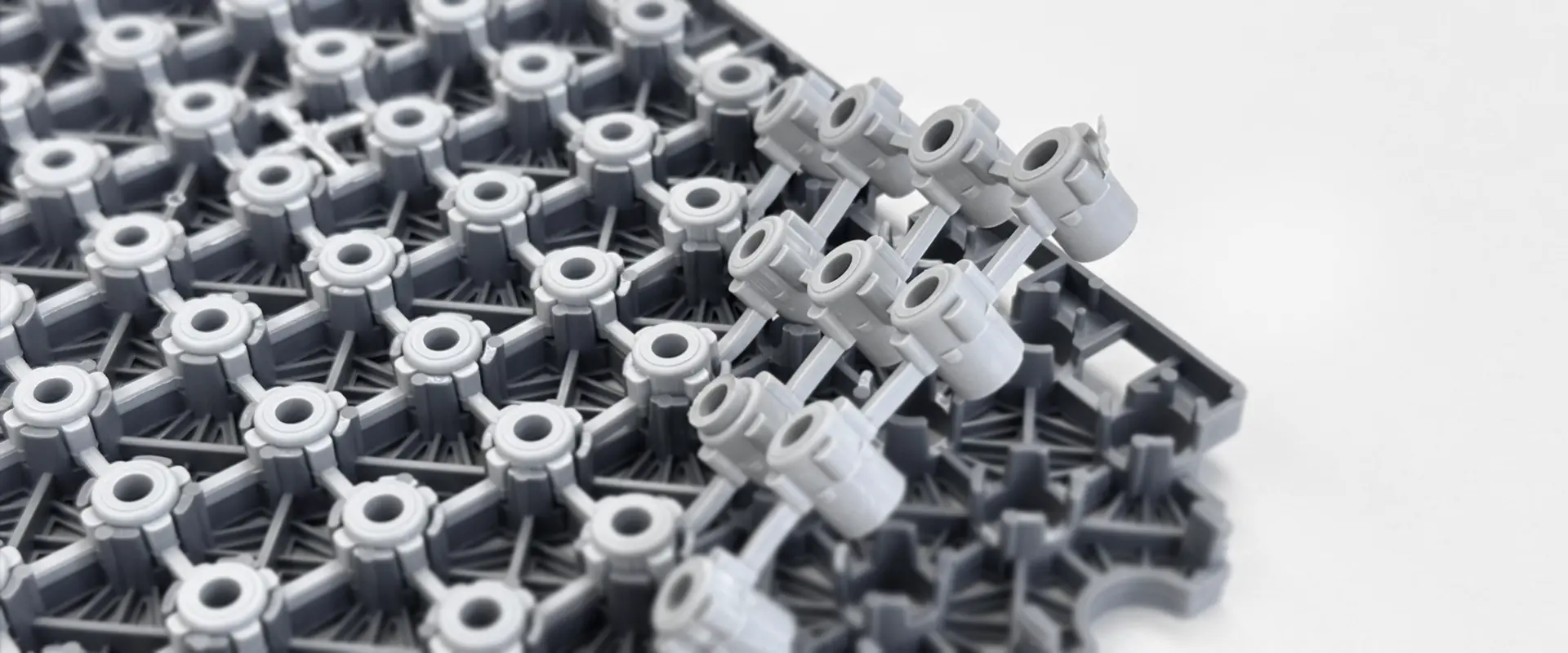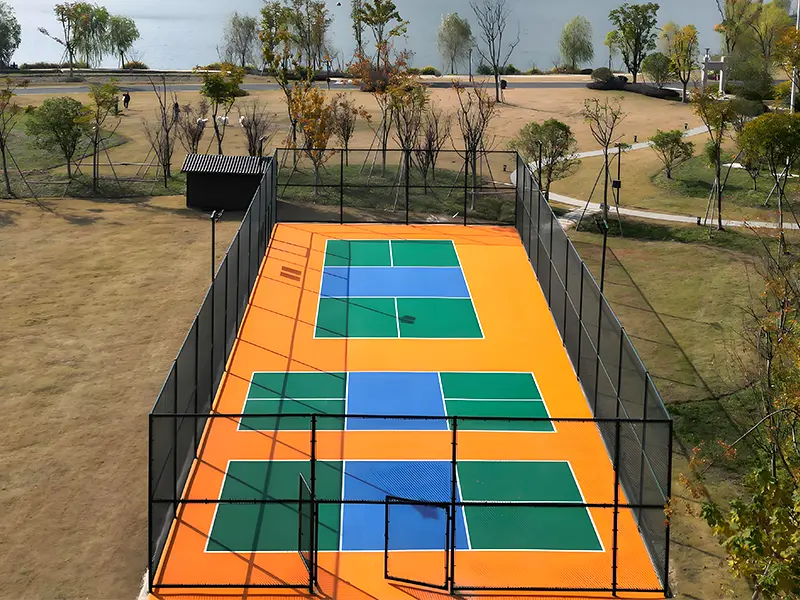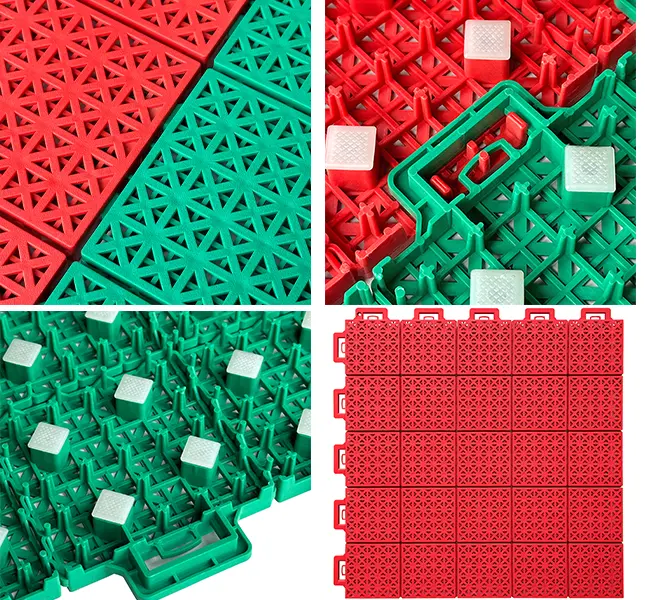Stable commitment to every leap, customized every flat
Blog


Stable commitment to every leap, customized every flat
Blog

The Pickleball Modular Tile System is a game-changing solution specifically designed for the outdoor sport of pickleball. These interlocking modular tiles combine durability, portability, and sport-specific performance, making them ideal for a variety of surfaces, from professional tournaments to backyard courts.
This guide delves into the technical design, key benefits, material options, and sourcing strategies of modular pickleball courts, aiming to help venue managers, community organizers, and enthusiasts make informed decisions.
Pickleball’s hybrid nature (blending tennis, badminton, and table tennis) creates unique requirements for court surfaces—requirements that modular tiles are uniquely positioned to meet:
Pickleballs are lightweight (26-29g) and have a porous plastic surface, meaning they rely on the floor to deliver consistent rebound. The International Federation of Pickleball (IFP) mandates a ball rebound rate of 70-80% (vs. concrete’s 55-60%). Modular tiles are engineered with controlled elasticity to hit this sweet spot, ensuring players can predict shots and maintain competitive integrity.
Pickleball involves constant quick stops, pivots, and short jumps—movements that strain knees, ankles, and hips. A modular system with targeted shock absorption (20-30% per EN 14808) reduces joint stress by 35% compared to hard surfaces, critical for casual players (60% of participants are 55+) and elite athletes alike.
Players often change direction at high speeds, even in sweaty conditions. Modular pickleball court tiles feature textured surfaces with a dry slip coefficient (COF) ≥0.65 and wet COF ≥0.55 (EN 14411 R10), preventing slips without creating excessive friction that hinders movement.
Unlike permanent courts, modular systems thrive in “non-traditional” pickleball spaces—community centers, school gyms, parking lots, or backyard patios. Their interlocking design allows for quick setup and teardown, turning underused areas into functional courts in hours.

Modular flooring outperforms traditional surfaces in four key areas that matter most to pickleball users:
Setup Speed: A standard pickleball court (20ft × 44ft / 6.1m × 13.4m) can be installed by 2-3 people in 2-3 hours—no glue, nails, or heavy equipment required. PP Interlocking tiles snap together like puzzle pieces, with edge trim for a finished look.
Portability: Tiles are lightweight (2-4kg each) and stack compactly, making them ideal for temporary events (tournaments, pop-ups) or home users who want to store the court when not in use.
Subfloor Versatility: Works on concrete, asphalt, wood, or even carpet—no expensive subfloor preparation (e.g., self-leveling concrete) needed. This cuts installation costs by 40% compared to glued flooring.
Wear Resistance: Premium modular tiles (e.g., PP or PVC) have a wear layer thickness of 1.2-1.5mm, achieving ISO 10581 Class 4-5 abrasion resistance (4,000+ revolutions). This withstands 200+ weekly players (community courts) or 500+ hours of annual use (home courts) for 8-12 years.
All-Weather Performance: Outdoor-rated tiles feature UV stabilizers to resist fading (4,000 hours of direct sunlight testing) and temperature tolerance from -30℃ to 70℃, making them suitable for harsh climates (snowy Northern Europe, scorching Middle Eastern summers).
Drainage Design: Outdoor tiles include a 10-15mm gap between the tile and subfloor, with channeled undersides that drain rainwater in 5-10 minutes—eliminating standing water and allowing play shortly after rain.
Easy Cleaning: Non-porous surfaces repel dirt, sweat, and pickleball court cleaner (mild detergent + water). A quick sweep or hose-down is sufficient for regular upkeep—no waxing, sanding, or refinishing.
Localized Repair: Damaged tiles (e.g., cracked from a falling branch) can be replaced individually for $10-20 per tile, vs. $50-80 per square meter for resurfacing concrete.
Total Cost of Ownership (TCO): While upfront costs ($30-60 per square meter) are higher than concrete, modular tiles have a TCO 30% lower over 10 years due to minimal maintenance and no full-court replacement.
Color Options: Tiles come in standard pickleball colors (blue, green, gray) or custom hues to match community branding or backyard aesthetics. Contrasting boundary lines can be integrated into the tiles (no painting required) for long-lasting visibility.
Thickness Variations: 10mm tiles for home/light use, 15mm for community courts, and 20mm for professional tournaments—allowing users to match performance to their needs.
Multi-Sport Adaptability: Tiles can be reconfigured for badminton, tennis, or futsal by adding temporary lines, maximizing space utility for multi-purpose facilities.
The performance of a modular system hinges on its material and engineering. Below are the most common materials and critical specs to evaluate:
| Material | Key Benefits for Pickleball | Ideal Use Case | Potential Drawbacks |
| Polypropylene (PP) | UV-resistant, lightweight, cost-effective, drainable | Outdoor courts, temporary events | Less shock absorption (20%) |
| PVC | Superior cushioning (25-30% impact absorption), quiet | Indoor courts, home/community | Less durable outdoors (needs UV coating) |
| Rubber | Maximum shock absorption (30-35%), slip-resistant | Professional tournaments, gyms | Heavier (harder to transport), higher cost |
| Composite (PP+Rubber) | Balances durability, cushioning, and cost | All-purpose (indoor/outdoor) | Slightly higher upfront cost |
Ball Rebound Rate: 70-80% — test with a standard pickleball dropped from 1.5m.
Shock Absorption: 20-30% — critical for player joint health.
Slip Resistance: Dry COF ≥0.65, wet COF ≥0.55 (EN 14411) — avoid tiles with glossy surfaces.
Locking System: Look for “3-point interlock” (top, middle, bottom) with tensile strength ≥60N/cm to prevent shifting during play.

Modular pickleball tiles aren’t one-size-fits-all. Below are tailored recommendations for common use cases:
Recommendation: 20mm rubber or composite tiles (e.g., 80% PP + 20% rubber).
Key Features: High shock absorption (30%+), precise ball rebound (75-80%), and seamless interlocking to handle intense play.
Example: The USA Pickleball National Championships uses composite modular tiles for consistent performance across multiple courts.
Recommendation: 15mm UV-treated PP tiles with drainage.
Key Features: Weather-resistant, low maintenance, and customizable colors to match local branding. Add shaded areas to extend lifespan in sunny regions.
Case Study: A community park in Seattle installed 4 modular pickleball courts (1,100 sq.m) for $45,000. The courts are used 12 hours daily and have required only 2 tile replacements in 3 years.
Recommendation: 10-12mm PVC or lightweight composite tiles.
Key Features: Easy to install/store, quiet (reduces neighbor noise), and available in custom sizes for odd-shaped backyards.
Pro Tip: Opt for interlocking tiles with a rubber underlay for extra shock absorption if the court is used by kids or seniors.
Recommendation: 10mm PP tiles (portable kit with carry bags).
Key Features: Lightweight (2kg/tile), fast setup (1 court/2 hours), and compatible with any flat surface (parking lots, mall floors).
Use Case: Corporate wellness events or festival activities—tiles can be installed in the morning and removed the same evening.
To avoid costly mistakes, follow this step-by-step procurement framework:
Location: Indoor (prioritize cushioning/noise) or outdoor (prioritize UV/drainage).
Usage Frequency: Low (home: <10 hours/week) vs. high (community: >20 hours/week).
Budget: Allocate 60% to tiles, 20% to edge trim/accessories, 20% to installation (if hiring professionals).
Ensure the system meets IFP performance standards (ball rebound, slip resistance).
Check for third-party certifications: SGS (abrasion/wear), GREENGUARD Gold (indoor air quality), and ISO 9001 (manufacturing quality).
Request 30cm×30cm samples and conduct these tests:
Ball Rebound: Drop a pickleball from 1.5m—rebound should reach 1.05-1.2m (70-80%).
Slip Resistance: Wet the sample and rub a tennis shoe over it—no sliding = good COF.
Locking Strength: Snap two tiles together and pull them apart—resistance indicates a strong interlock.
Warranty Coverage: Ensure the warranty includes material defects, locking system failure, and UV fading.
Replacement Parts: Confirm the manufacturer keeps tiles in stock for quick replacements (critical for high-use courts).
Installation Resources: Look for English/Spanish installation manuals, video tutorials, or on-site training for large projects.
Compare TCO over 10 years: Modular tiles ($30-60/sq.m) vs. concrete ($15-25/sq.m + $5-10/sq.m annual resurfacing).
Factor in downtime: Modular tiles require 0 downtime for maintenance, while concrete resurfacing closes the court for 3-5 days.
Choosing the right surface material for your pickleball court flooring not only enhances the playing experience but also balances procurement and maintenance costs. PVC sports flooring can be used both indoors and outdoors, and outdoor interlocking floor tiles can be used for a wide range of sports, including pickleball and basketball.
Leave Your Message
Message us for free samples and quotes!